Professional design of hot water supply in energy-efficient buildings
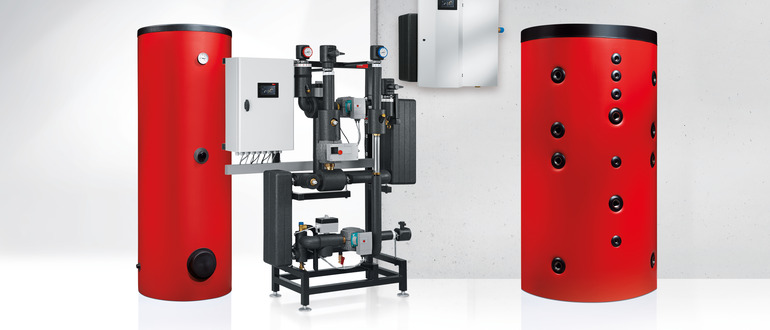
Professional design of hot water supply in energy-efficient buildings
Professional design of hot water supply in energy-efficient buildings – technical principles, standards and practical examples
- Blog
- Expert - Engineer
With the increasing optimization of energy systems in residential buildings, the ratio between space heating and domestic hot water demand is shifting significantly. Improved insulation standards and the use of high-quality windows mean that the specific energy requirement for space heating is being reduced considerably, while the domestic hot water requirement remains almost constant.
Studies into the development of building regulations and energy standards show that domestic water heating accounted for about 10% of the total energy demand in buildings up to 1975, but can reach up to 75% in the passive houses that are being built nowadays. This development makes it clear that the domestic hot water supply must be given at least the same importance as space heating when planning building services in the future.
This blog explains the technical principles and normative requirements (DIN 4708, DIN 1988-300) for the needs-based design of domestic hot water supply in residential buildings. In addition to calculation methods such as the cumulative line process and boiler supplement, key aspects such as consumption peaks, hygiene and system selection are presented in a practical way.
Domestic hot water demand, consumption structure and demand coverage
The average daily water consumption per person in most European countries is between 120 and 150 litres, with around 50 litres of hot water being used per person per day as a practical planning figure.
For a four-person household, this results in an annual hot water requirement of around 75000 litres; depending on the choice of system and efficiency, the cost of heating this water can be estimated at 1000 euros per year. This value can be significantly reduced by using efficient systems and conserving resources.
The supply of domestic hot water must be guaranteed all year round and in sufficient quantities. When it comes to system design, it is essential to precisely analyse both the specific demand – which varies depending on user behaviour, building type and equipment – and the draw-off characteristics, i.e. the distribution and level of consumption peaks over the course of the day. Only by taking these factors into account can a domestic hot water system be dimensioned economically and reliably so that it reliably covers both everyday requirements and exceptional peak loads.
Basic factors for planning domestic hot water systems: water quality, water hardness and hygiene
The quality of the water is a decisive factor for the planning, operation and durability of the water heating system. The water quality should therefore be analysed as early as the planning phase so that suitable materials, protective measures and any necessary treatment processes can be selected in a targeted manner.
Water never occurs in nature as a pure substance, but always contains dissolved substances, especially ions of salts. The most important influencing factors are temperature, dissolved salts and free and bound gases, which significantly determine the chemical processes within the system.
The origin of the water (groundwater, primary rock, limestone) and the resulting water hardness vary considerably from region to region. The total hardness results from the carbonate and non-carbonate hardness and is given in German degrees of hardness (°dH) or mmol/l (1 °dH = 0.178 mmol/l calcium = 7.14 mg/l calcium).
Professional design of hot water supply in energy-efficient buildings – technical principles, standards and practical examples
Taking account of hygiene requirements
Legionella are pathogenic bacteria that can cause Legionnaire's disease, which is potentially fatal. While the oral intake of legionella in domestic water is considered harmless, the inhalation of aerosols – for example when showering – poses the real risk. Legionella prefer to multiply at temperatures between 32 and 42 °C and are only reliably killed at 60 to 65 °C.
Good to know:
Hot water storage tanks with pronounced temperature stratification are unfavourable from a hygiene perspective. Regular desludging is recommended, as sludge provides an ideal breeding ground for germs.
Circulating the hot water right up to the tap and at least temporarily increasing the operating temperature are essential to ensure hygiene. In the case of electrical trace heating without circulation pipe, it is possible to conduct thermal disinfection via an automatic switching device.
Rarely used pipe branches represent a particular risk of contamination and should be shut down.
Consumption peaks and simultaneity – basic design principles
The draw-off characteristics describe the course of hot water consumption over time and varies depending on the type of building. Residential buildings typically have consumption peaks in the morning and evening hours, while hotels, educational establishments or office buildings have different profiles throughout the day. Maximum simultaneity of draw-off at all draw-off points is practically excluded.
The realistically expected simultaneity, which is derived from the specific consumption structure, is therefore of decisive importance for the design. Total flow rates are converted into peak volume flows in compliance with the standards (in accordance with DIN 1988-300), taking into account the simultaneity behaviour – this ensures a reliable and economical selection of dimensions.
System selection: central and decentralised domestic water heating
The choice of a suitable domestic hot water system depends on the type of building, utilisation and hygiene requirements. Central storage tank and storage tank charging systems are standard in residential buildings. In hotels, offices and industrial buildings, on the other hand, decentralised systems such as continuous-flow or fresh water stations are often preferred.
All infrastructural framework conditions (available installation spaces, installation dimensions, room heights) must be taken into account as early as the planning phase, as they have a significant influence on the choice of system and its feasibility. The choice between vertical and horizontal storage tanks and the dimensioning of buffer storage tanks are based on this.
Comprehensive knowledge of the planned domestic water heating system is a prerequisite for ensuring a hygienically perfect, economical and reliable supply.
Bases of calculation: Domestic hot water requirement and design according to DIN 4708
The application of DIN 4708 in conjunction with the calculation principles such as the boiler supplement, the cumulative line process and the determination of the peak flow rate enables an economical and standardised design of domestic water heating systems with scope for future adaptations in residential buildings.
DIN 4708 is the authoritative standard for the planning and dimensioning of domestic hot water systems in residential buildings (excluding hotels, retirement homes and special buildings).
- The standard apartment with demand index N=1 serves as a reference: it comprises 4 rooms, 3 to 4 persons and a standard bathtub (SBT 1) as the relevant draw-off point.
- The energy requirement for domestic hot water in a standard apartment is around 20370 Wh (3.5 × 5820 Wh).
- The draw-off period, a typical consumption profile, is divided into 5 draw-off times and 4 interval times. The third draw-off has the largest consumption peak with a duration of 10 minutes, and is decisive for the peak capacity design of fresh water stations.
- Standardised tables exist for demand indices from N=1 to N=300, which enable comparable and reliable dimensioning in compliance with the standards, regardless of the actual number of occupants and individual user behaviour.
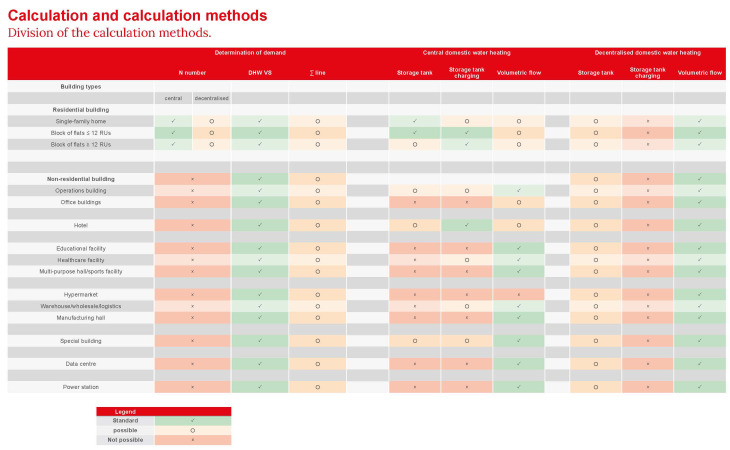
Figure 1: Division of the calculation methods | Source: Hoval AG
Selection and design of domestic hot water storage tanks (DIN 4708)
There are 3 central requirements for the choice of storage tank:
- The performance index (NL) of the storage tank must at least correspond to the calculated demand index N.
- The boiler capacity must at least cover the continuous domestic hot water output at 10/45 °C.
- If the boiler is used for space heating and domestic water heating, a boiler supplement for domestic hot water must be taken into account. A practical value is the direct application of the demand index N in kW as a supplement. In energy-efficient buildings, this supplement can exceed the heating output for space heating.
Peak draw-off rate, cumulative line process and peak flow rate
For complex special cases (hotels, residential homes), the cumulative line process precisely determines the heat demand by adding up the heat quantities of the consumers over time.
2 important values are derived from this:
- Total heat demand (kWh) at the end of the demand period
- Maximum heat output demand (kW) at the maximum gradient of the cumulative line
The resulting consumption data enables optimised system dimensions to be selected.
The total flow rates are converted into peak flow rates in accordance with DIN 1988-300. The simultaneity behaviour of the consumers is included in the dimensions as standard. DIN 1988-300 contains various diagrams and tables which, depending on the type of building and a corresponding simultaneity factor, allow the total flow rates to be converted into a peak flow rate.
Boiler supplement and requirements (DIN 4708-2)
Due to decreasing heating requirements with constant or increasing domestic hot water demand, domestic water heating often represents the predominant demand on output.
DIN 4708-2 specifies 3 central requirements for boiler output:
- The performance index NL of the storage tank must at least correspond to the demand index N.
- The boiler capacity QK must be at least as high as the continuous output QD required to achieve the NL.
- The boiler output QK must be at least QK ≥ QN bld + QDHW, where
- QN bld is the heating demand of the building,
- Q DHW is the boiler supplement for domestic hot water.
A practical estimate for QDHW is the demand index N as a kW value. The exact value is found using the tables and diagrams in DIN 4708.
Practical tips for system planning
Procedure for designing a domestic water system
The design is carried out sequentially in 4 consecutive steps that systematically structure the selection of components and the design of the output of the heat generator:
- Calculation of the NL number as the basis for selecting dimensions
- Selection of the storage tank size or module based on the NL number or according to the module catalogue
- Selecting dimensions of the buffer storage tank (for fresh water systems, depending on the heat generator output and desired draw-off rate)
- Consideration of the output supplement for constant domestic hot water comfort in accordance with DIN 4708-2
Design example for residential building
The following design example shows the design of domestic hot water heating with Hoval systems based on a block of 25 flats. The most important key data are:
- Block of 25 flats
- User output (performance index NL) = 25
- Heat demand (QH) = 75 kW
Systems under consideration:
- Storage tank solution
- TransTherm aqua L buffer storage solution
- TransTherm aqua F fresh water system
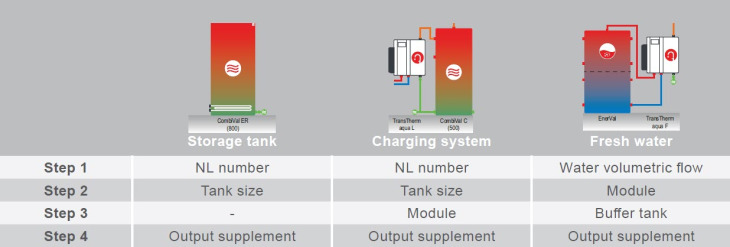
1. Design example of a coil storage tank – design of the storage tank size taking the Hoval CombiVal ER (800) as an example
The design of the coil calorifier is based on catalogue tables with the following specifications:
- Performance index NL = 25
- Domestic hot water temperature: 45 °C (Comfort)
- Charging temperature: 70 °C
The design of the storage tank size is based on catalogue tables:
- Performance index NL = 25
- Domestic hot water temperature: 45 °C (design for Comfort)
- Charging temperature: 70 °C
Good to know: When selecting the storage tank, the next largest storage tank is always selected with a volume that at least fulfils or exceeds the calculated performance index NL. This takes into account uncertainties in water demand and possible changes in the load profile, in order to ensure a permanently reliable domestic hot water supply based on demand.
Selection of next larger storage tank according to catalogue table:
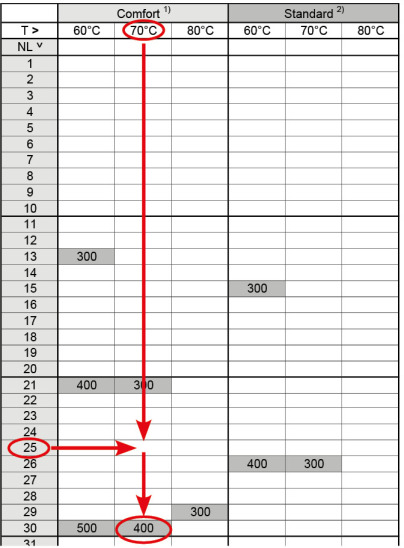
Example for deriving the continuous domestic hot water output with a storage tank volume of 400 litres:
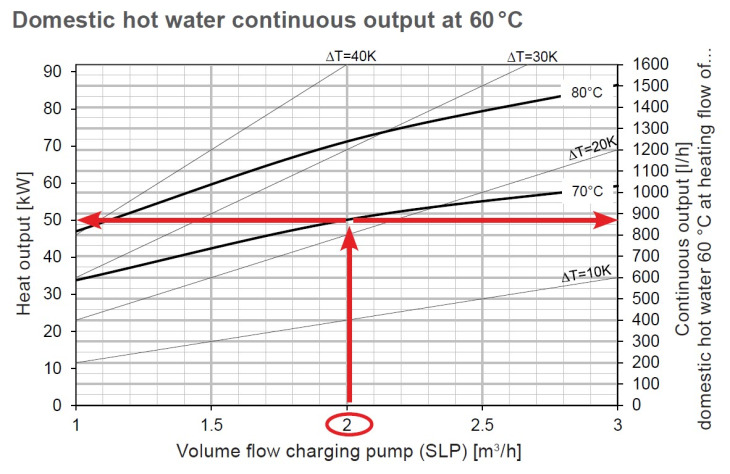
- Assumption: charging flow rate of 2 m³/h
- Intersection point with curve T1 = 70 °C: the average thermal output at charging temperature 70 °C is approx. 50 kW
- The boiler supplement is determined on the basis of the rule of thumb: Boiler supplement * rule of thumb = QH + 50% of the connected load of the calorifier
- This produces a required boiler output of:
- 75 kW + 25 kW = 100 kW.
- (Note: 75 kW corresponds to the building heating capacity in "2. Design example of buffer storage solution”.)
- The resulting continuous output is approx. 870 l/h.
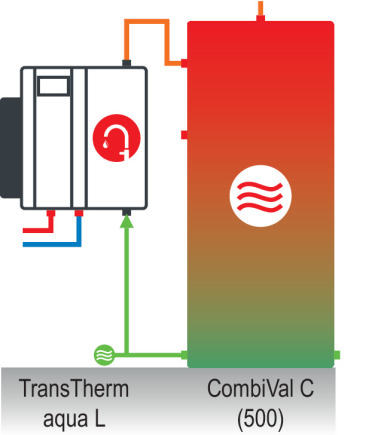
2. Design example of buffer storage solution
- Based on the NL number and storage tank size, the storage tank charging module is designed according to the catalogue data.
- Boiler supplement = QH + 50% of charging system connected load
Example of the design of a storage tank charging module with a storage tank volume of 500 litres:
- Table data | Technical data according to catalogue
- Results in the selection of the TransTherm aqua L (1-10) storage tank module with a performance index NL = 25 and a storage tank size of 500 litres.
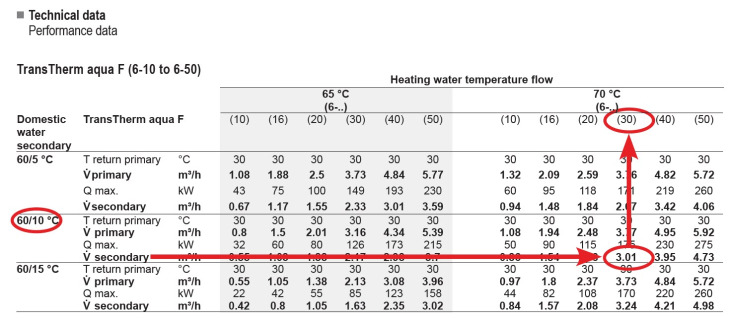
Figure 3: Table data | TransTherm aqua L output data | Source Hoval AG
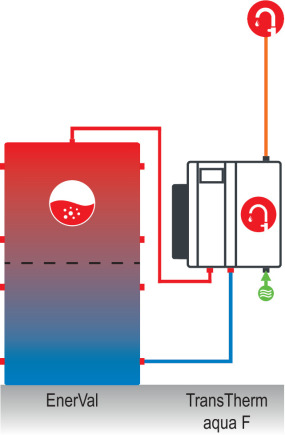
3. Design example of a fresh water system
The design of a fresh water system is based on the following specifications:
- Peak flow rate VS in accordance with DIN 1988-300 (at 45 °C)
- Conversion to 60 °C
- Design of heating water buffer storage tank
- Boiler supplement according to table
Calculation and peak volumetric flow according to DIN 1988-300
- Calculation with Excel
- Reading of the values for VS at 60 °C
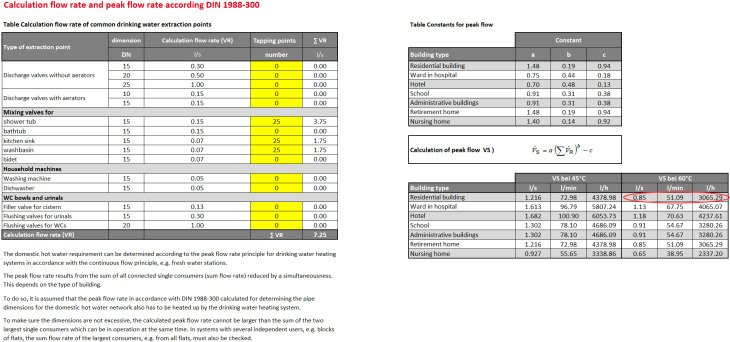
Figure 4: Calculation flow rate and peak flow according to DIN 1988-300 | Source: Hoval AG
Example of the design of a fresh water module in accordance with table | Technical data
- Table in the catalogue
- Domestic water 60 / 10 °C
- Conversion from l / h to m³ / h
- V secondary approx. 3 m³ / h
- Results as the selection of the TransTherm aqua (6-30) storage tank module

Figure 5: Table for selection of fresh water module | TransTherm aqua F output data | Source: Hoval AG
Calculation of the required buffer volume
For reliable domestic hot water preparation, fresh water stations are usually connected to a heating water buffer storage tank. The required volume of the buffer storage tank depends largely on the actual domestic hot water demand of the installation, the temperature of the water in the storage tank and the user behaviour. Only by carefully coordinating these factors can a domestic hot water system be dimensioned economically and reliably.
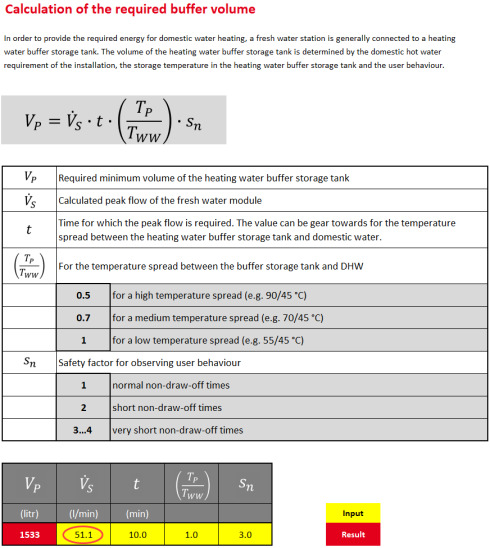
Figure 6: Determining buffer storage tank volume | Source: Hoval AG
Buffer storage tank and domestic hot water configuration
- Supplement from table: Charging output supplement for the heating water buffer is shown in the table.
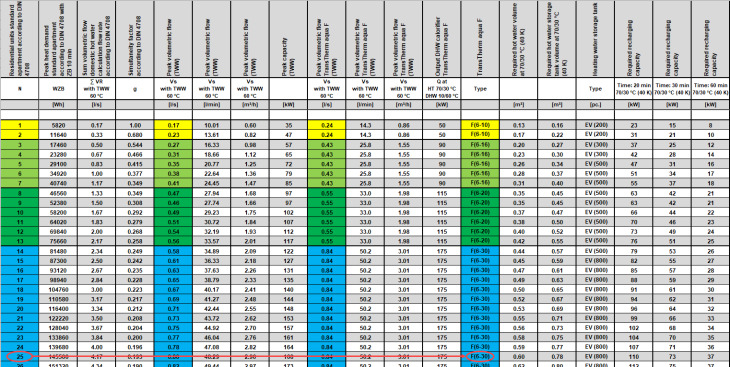
Figure 7: Calculation method for adapting the buffer storage tank volume to the domestic hot water demand
Downloads for planners
Domestic water systems factbook (PDF): Comprehensive information about Hoval domestic water and fresh water systems, including technical data, design examples and system overviews. The factbook supports the precise planning and design of domestic hot water systems. Download Domestic water systems factbook
- Calorifiers/domestic water storage tanks product catalogue (PDF): Detailed product overview of storage tank modules, performance indices, temperature ranges and connection options for a wide range of applications. Download calorifiers product catalogue
Related links
- Hoval domestic water systems: Discover detailed product information and technical data on our domestic water systems. To domestic water systems product page
- Technical advice and support: Direct contact with our experts for customised project support and design assistance.